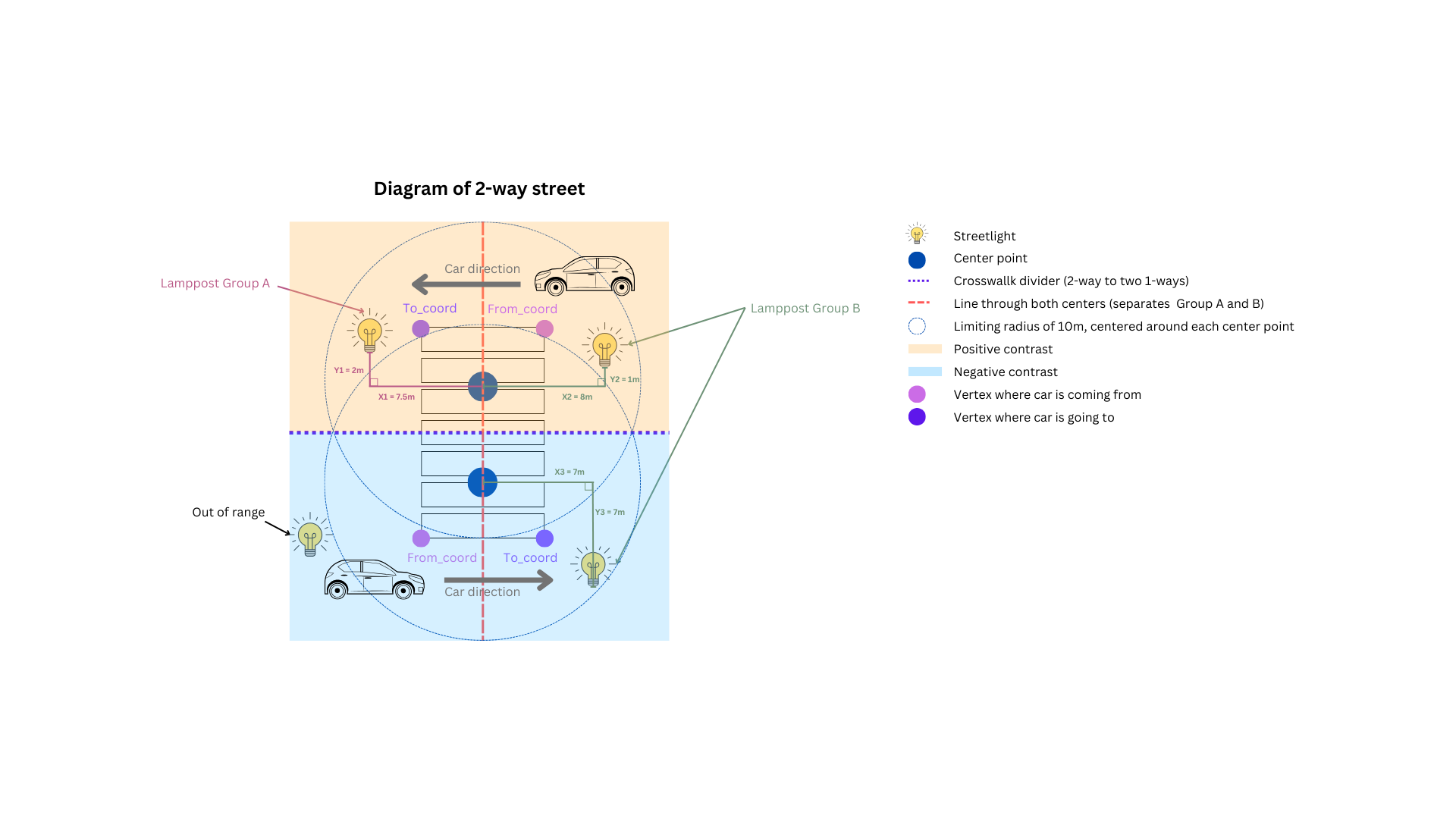Crosswalk Brightness and Contrast Heuristic¶
Overview¶
This document outlines the process and algorithms used to compute contrast heuristic values for crosswalks. The calculation involves multiple steps, including data loading, crosswalk edge classification, center detection, vehicle direction analysis, and contrast computation.
Process Flow¶
Data pipeline for crosswalk contrast and brightness heuristic¶
Steps¶
Load Datasets to Database:
GeoJSON datasets for crosswalks, streetlights, and street segments are loaded into a DuckDB database.
Classify Crosswalk Edges:
Crosswalk polygons are simplified to minimum bounding rectangles with exactly 4 edges.
Edges are decomposed, assigned IDs, and classified as vehicle or pedestrian based on street segment intersection.
A boolean
is_onewaycolumn is added to all segments based on the intersecting street segment’s attribute to distinguish one-way streets from two-ways.
Find Crosswalk Centers:
One-way crosswalks receive a single center point, labeled ‘A’, located at the centroid of the intersection between the crosswalk and street segment.
Two-way crosswalks are assigned two centers (A, B) calculated from interpolated midpoints between pedestrian edges and street segment intersections.
Note
Direction of vehicles is critical in determining the contrast level of a pedestrian observed by the driver. Thus, we identify the direction assuming that the vehicle always drives on the right side of the road, except for one-way streets.
Identify Vehicle Direction:
One-way streets: Use the street segment’s marked one-way direction to determine vehicle direction.
- Two-way streets:
- Case 1: If the crosswalk center’s X value is greater than the street center point’s X value, we assume the vehicle is moving from
y_smallertoy_larger. – For the
from_coord, choose the vertex of the pedestrian edge with the smaller Y value. – For theto_coord, choose the vertex with the larger Y value.
- Case 1: If the crosswalk center’s X value is greater than the street center point’s X value, we assume the vehicle is moving from
- Case 2: If the crosswalk center’s X is less than the street center point’s X value, we assume the reverse:
– For
from_coord, choose the vertex with the larger Y. – Forto_coord, choose the vertex with the smaller Y.
- Case 3: If the crosswalk center’s Y is greater than the street center point’s Y value, we assume the vehicle is moving from
x_largertox_smaller. – For
from_coord, choose the vertex with the larger X value. – Forto_coord, choose the vertex with the smaller X value.
- Case 3: If the crosswalk center’s Y is greater than the street center point’s Y value, we assume the vehicle is moving from
- Case 4: If the crosswalk center’s Y is less than the street center point’s Y value, then:
– For
from_coord, choose the vertex with the smaller X value. – Forto_coord, choose the vertex with the larger X value.
Find Nearby Streetlights:
For each crosswalk center, streetlights within ~20 meters are collected using
ST_DWithin_Spheroidand precise distance viaST_Distance_Sphere.streetlight_idandstreetlight_distare stored as arrays indexed per crosswalk center.
Classify Lights by Side:
Create a directional line
a_to_bbetween center A and center B. In case of a way with only one center, the line is drawn from the center to the midpoint of a pedestrian edge as a synthetic center B.Create a vector
from_to_tofromfrom_coordtoto_coordto mark the direction of traffic.Create lines
center_to_lightfrom the center to each streetlight.The cross product of the
a_to_bvector and thefrom_to_tovector is calculated to determine the reference “from-to” direction.The cross product of the
a_to_bvector and thecenter_to_lightvector is calculated to determine the relative direction of the streetlight.If the signs of the two cross products match these lines, then the streetlights are labeled as on the
toside, otherwise as on thefromside.Each classified streetlight entry retains its distance and calculated angle to the crosswalk direction.
Compute Brightness and Contrast Heuristics:
- Two heuristics are computed:
Contrast heuristic: \(\sum \left( \frac{1}{{\text{distance}^2}} \right) * |\sin(angle)|\)
Brightness heuristic: \(\sum \left( \frac{1}{{\text{distance}^2}} \right)\)
Results are grouped by center and stored in
crosswalk_centers_contrast.- Classification Logic: (with input threshold value of 0.01)
- If either side has a heuristic of 0:
If the difference is ≤ 0.005 ->
no contrastIf ≤ 0.0075 ->
weak contrastElse ->
strong contrast
- If both sides have heuristics:
≤ 0.0075 ->
no contrast≤ 0.01 ->
weak contrastElse ->
strong contrast
